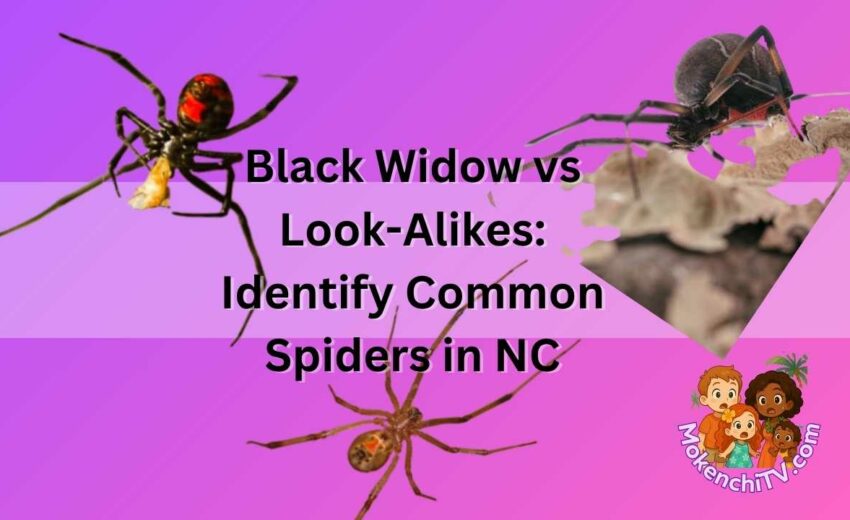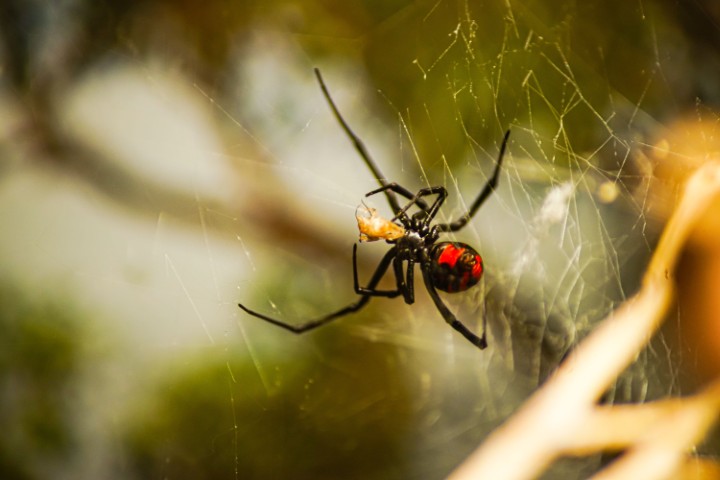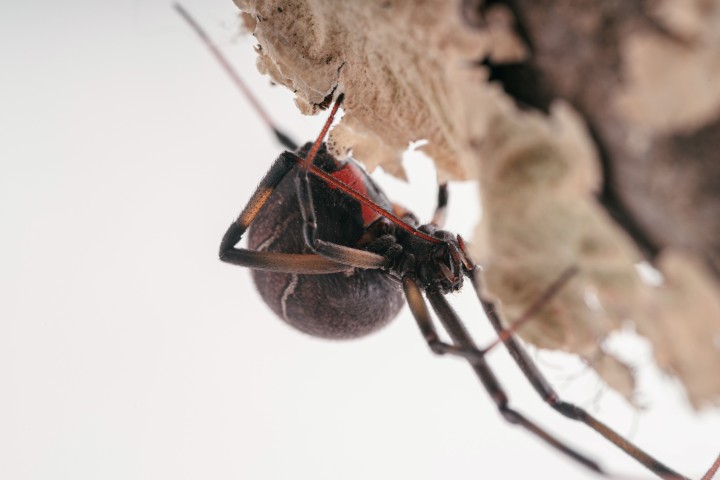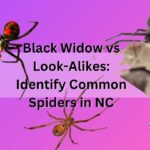
The other day we were doing some much needed cleaning around our office space when we ran into a black spider with a distinctly round abdomen. Immediately we panicked thinking it was a black widow spider until hubby looked closer and realized it lacked key features that typical of this nefarious spider.
Upon closer inspection we realized that our little home invader actually wasn’t a black widow spider at all. Even though it mimicked one closely, we had to take a few breaths to realize it was different. But it got me wondering how many others might make the same mistake!
Summer in North Carolina brings many things like sunshine, beach days, backyard barbecues…and…un/fortunately…spiders. If you’re like us, your first reaction upon seeing any shiny black spider is to panic and wonder if it’s a dangerous, even if not the one we’re focusing on today…
Outside of the really dangerous spiders, we don’t kill spiders since they are important to environmental balances. Yet, with kids running barefoot through grass, climbing trees, and exploring sheds and garages, it’s understandable to be very concerned.
But here’s some good news: not every black, shiny spider you spot is the infamous black widow.
So let’stake a deep dive into:
- understanding these spiders better
- learn to identify the real threats
- distinguish them from harmless look-alikes
This knowledge will ease your mind, helping your family safely enjoy all the adventures summer has to offer.
Disclaimer: This article is intended for informational purposes only and aims to help you identify spiders and distinguish harmless varieties from potentially dangerous ones. Always exercise caution when encountering spiders, and avoid handling them directly. If you’re uncertain or uncomfortable identifying or removing spiders, seek professional assistance from pest control or wildlife management experts. In the event of a spider bite, especially from a spider you suspect might be dangerous, seek immediate medical attention.
Understanding the Black Widow Spider

The black widow spider (Latrodectus mactans) is perhaps the most feared spider in the Southeast, including North Carolina. Recognizable by its glossy black body and the iconic red hourglass marking on the underside of its abdomen, the black widow can cause justified concern.
These spiders prefer dark, secluded spaces. You’ll typically find them in woodpiles, garages, basements, or garden sheds. They thrive in warm climates, favoring temperatures between 70–90 degrees Fahrenheit. Though their venom is potent, bites are relatively rare, occurring primarily when the spider feels threatened or trapped against skin.
What to do if you encounter a black widow:
- Keep calm and slowly move away without disturbing the spider.
- If found indoors or near play areas, carefully remove the spider using gloves and a container, or contact professional pest control.
- Seek medical attention immediately if bitten.
Common Spiders Mistaken for Black Widows
Fortunately, several harmless spiders closely resemble black widows, leading to frequent mistaken identities. Let’s explore these spiders and learn how to confidently tell them apart.
1. False Black Widow (Steatoda grossa)
False black widows are among the most common spiders mistaken for genuine black widows. They share the glossy black or dark brown appearance and similar body shape.
How to tell the difference:
- The false black widow lacks the distinct red hourglass marking, instead having lighter-colored or faint, irregular marks.
- False widows typically have a more elongated abdomen compared to the more rounded shape of true black widows.
Preferred environment:
- Often found indoors, especially in basements, garages, and sheds, much like true black widows.
- They prefer temperatures between 60–85 degrees Fahrenheit and thrive in dry, undisturbed locations.
What to do if you encounter a false black widow:
- No special precautions needed; simply relocate it outdoors if desired.
2. Red-Spotted Ant Mimic Spider (Castianeira descripta)
These spiders mimic ants in behavior and appearance. Their black and reddish markings often cause confusion.
How to tell the difference:
- Red-spotted ant mimic spiders have clear red or orange markings along their bodies, unlike the black widow’s singular red hourglass.
- They are significantly smaller and exhibit quick, jerky movements, unlike the black widow’s more deliberate motion.
Preferred environment:
- Found primarily outdoors around plants, flowerbeds, and grassy areas.
- Prefers moderate temperatures and is common in summer months in sunny gardens.
What to do if you encounter a red-spotted ant mimic spider:
- These spiders pose no threat; observe or gently relocate them if indoors.
3. Northern Black Widow aka Brown Widow (Latrodectus variolus)

A close relative to the southern black widow, the Northern Black Widow aka Brown Widow Spider, shares similarities but has subtle differences that often confuse people.
How to tell the difference:
- Northern black widows have a series of red dots or broken hourglass shapes rather than a single solid red marking.
- Slightly smaller and less shiny than the southern black widow.
Preferred environment:
- Commonly found in undisturbed wooded areas, rock piles, and logs.
- Prefers slightly cooler, shadier locations than southern black widows.
What to do if you encounter a northern black widow:
- Treat it similarly to the southern black widow; remove carefully or seek professional assistance.
4. Broad-Faced Sac Spider (Trachelas tranquillus)
This spider has a glossy appearance and can appear black or deep brown, often mistaken at a quick glance for a black widow.
How to tell the difference:
- Broad-faced sac spiders lack any distinct red markings.
- Their bodies are less spherical, with broader faces and prominent jaws.
Preferred environment:
- Frequently found indoors around windows, ceilings, and corners.
- Prefer moderately warm temperatures around 65–80 degrees Fahrenheit.
What to do if you encounter a broad-faced sac spider:
- They are harmless, but you can relocate them outdoors if they cause discomfort.
5. Parson Spider (Herpyllus ecclesiasticus)
The parson spider is another shiny, dark spider with light markings that might cause confusion, particularly at night.
How to tell the difference:
- It features a white or gray marking along its abdomen that resembles a clerical collar, distinct from the red hourglass of a black widow.
- Parson spiders are quicker and typically more active.
Preferred environment:
- Typically outdoor dwellers, found in leaf litter, woodpiles, and beneath stones.
- Thrive in warm summer months, active mostly at night.
What to do if you encounter a parson spider:
- Harmless to humans, simply let them be or gently move them outside.
Keeping Your Family Safe and Stress-Free
Knowing these differences can significantly ease your mind as your family enjoys the great outdoors this summer. While it’s always good to exercise caution—like wearing gloves when handling wood or cleaning sheds—being able to confidently differentiate these spiders can prevent unnecessary panic.
Teach your children basic spider safety, such as checking shoes and garden gloves before use. With this knowledge, you’ll not only protect your family from genuine risks but also foster a healthier relationship with the natural world around you.
Remember, not every spider is a villain. Most play essential roles in controlling pests, ultimately making your garden and home a healthier place. This summer, embrace curiosity over fear, armed with the information you need to stay safe and relaxed.



Alyssa July 1, 2025
This is such a helpful and timely post, especially for families like ours who spend a lot of time outdoors! I had no idea there were so many spiders that closely resemble black widows. It’s definitely reassuring to learn how to tell them apart rather than instantly panic.
I’m curious, though—are there specific seasons when black widow sightings are more common in North Carolina, or are they active year-round? Also, do these spiders tend to wander indoors often, or do they mostly stick to sheds, woodpiles, and outdoor spaces?
Thank you for breaking this down in such an easy-to-understand way. I feel a little less anxious about our next backyard clean-up now!
Marlinda Davis July 7, 2025
Thank you so much for your kind words! I’m really glad the post helped ease some of that backyard anxiety, especially for families who love being outdoors.
Great questions, too! In North Carolina, black widow sightings are definitely more common in the warmer months, typically from late spring through early fall. That’s when they’re most active and looking for food or mates.
As for their preferred hangouts, they mostly stick to outdoor spaces like woodpiles, sheds, garages, and under patio furniture. It’s pretty rare for them to wander into the main living areas of a home, but it can happen if there’s easy access or lots of clutter.
Thanks again for reading and happy (safer!) backyard adventuring to you and your family!
The Investor July 2, 2025
The side-by-side comparison photos are really very useful, especially with the highlighting of the subtle differences in leg banding and abdomen shape between black widows and their lookalikes (like false widows). Your “red hourglass vs. red spots” tip is the clearest identifier I’ve seen.
The section on preferred habitats (woodpiles, cluttered garages) gives homeowners actionable inspection areas. Have you found certain seasons when encounters spike in North Carolina?
Most importantly, the first aid steps for suspected bites are concise but thorough. Too many guides overlook the “stay calm and clean the wound” basics.
Marlinda Davis July 3, 2025
Thank you so much for this thoughtful and encouraging feedback! I’m really glad the side-by-side comparisons and red hourglass vs. red spots tip helped—it’s one of those tiny details that makes a big difference when you’re trying to identify a spider quickly.
And yes—encounters here in North Carolina definitely tend to spike in the warmer months, especially late spring through early fall. That’s when spiders are more active and people are spending more time outside (and rummaging in those cluttered sheds and garages!).
I also appreciate you pointing out the first aid section. “Stay calm and clean the wound” sounds simple, but it’s often skipped—and it really is the foundation for handling any suspected bite properly.
Thanks again for your kind words and great question!
Martin July 2, 2025
Marlinda,
That article is a solid primer on the most common spiders in North Carolina! I really appreciate how it helps identify species that are truly dangerous, like black widows and brown recluses, versus those that look scary (cellar spiders, false widows) but are low-risk. Missing a few residents like southern house spiders and barn weavers is a minor oversight, but overall it keeps the info approachable and relevant. Have you considered adding something around advise for the first steps if bitten, like cleaning and ice, monitoring for severe reactions, and seeking medical help if symptoms escalate. I just thing it might add another dimension.
Kind regards,
Martin
Marlinda Davis July 3, 2025
Hi Martin,
Thank you so much for the thoughtful feedback—I really appreciate it! You’re absolutely right—adding first-aid guidance for bites would definitely make the article more helpful, especially for readers who might panic if they ever find themselves in that situation.
I’ll be updating the article soon to include those important first steps: cleaning the bite area, applying ice to reduce swelling, and keeping an eye out for signs of more serious reactions. Knowing when to seek medical attention is key, especially with species like black widows or brown recluses in the mix.
Thanks again for the great suggestion!
Warmly,
Marlinda
Michel July 2, 2025
Wow, I never knew that there were even black widow lookalikes. I have never come across a Black Widow myself, probably due to the fact that I live in a costal town in South Africa, so I don’t think they are natural inhabitants of this area. Nevertheless the spiders you get here still give a nasty bite, so you do need to teach your children to check gloves and shoes before putting them on as you do there.
What is the medical procedure that needs to be followed if you do get bitten by a black widow?
Marlinda Davis July 3, 2025
Hey Michel,
That’s such a great point about teaching kids to check gloves and shoes—such a simple habit, but it really makes a difference! And you’re right, the spiders in South Africa definitely have their own bite to watch out for.
Interestingly, South Africa does have black widow relatives called Button Spiders, and they’re just as venomous as the ones here in North America.
As for bites, if someone is bitten by a black widow (or button spider), it’s important to seek medical attention right away—especially if the person is very young, elderly, or has other health conditions. Doctors usually treat with pain relief, muscle relaxants, and in more serious cases, antivenom. Always better to be safe and get checked out!
Hope this helps,
Marlinda